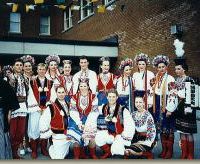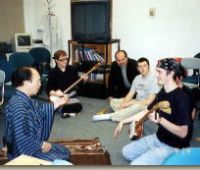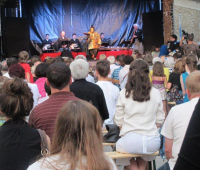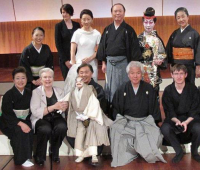Performances Outside of Japan
Tsuruga Wakasanojo has presented numerous performances in countries other than Japan, including in Europe, South America, North America, and Asia.
Often the question arises whether non-Japanese people would be able to appreciate shinnai, but the results have consistently been rave reviews.
“Shinnai is fun to see and to listen to” is one of Wakasanojo’s mottos. Overseas, he generally performs with the Kuruma Ningyo puppeteers, most especially the works Yaji-Kita and Kuzu no Ha.
Yaji-Kita is one of only a few humorous works in the shinnai repertoire. When performing overseas, Wakasanojo does as much as possible of the characters’ dialogue in the local language. Audiences are surprised and pleased. For example, in Brazil, the audience stamped on the floor to show their approval, and laughed heartily at the jokes. At a performance at a university in the United States, the audience of students were laughing so loudly that it was almost not possible to hear the subsequent lines.
In 2008, in Washington, DC, Wakasanojo performed a 50-minute portion of Yaii-Kita in English. He worked with several of his supporters to prepare this translation. Because some of the jokes in the original were puns that were impossible to translate into English, Wakasanojo wrote many new jokes for the all-English version. This was the first time in the history of shinnai that an entire work had been performed in any language other than Japanese. The performance received a standing ovation. Later in 2008, he repeated the all-English shinnai version of Yaji-Kita in Tokyo for an audience comprised mainly of non-Japanese.
Serious shinnai works are also highly regarded overseas. After a performance in New York City, Wakasanojo’s voice was described as sensual and mysterious.
Recently, Wakasanojo has received many requests to lecture at universities and to give workshops for children in the United States and UK. Audiences of all ages ask many questions and are interested in learning to play the shamisen.
Hereafter, Wakasanojo will continue to travel abroad, both to perform shinnai in concerts and also to educate people about the genre through lectures and workshops.
1977 – Korea (at the invitation of Asia Broadcast Exchange Association)
1979 – Hawaii (performance on a Japanese radio station)
1983 – France: Avignon Festival
1983 – France: Montpellier (International Music Festival)
1990 – Canada: Drummondville, Quebec (World Culture Festival)
1997 – Spain (invited by a Japanese corporation)
1998 – China (invited by Japan-China Friendship Association)
2000 – Brazil (4 cities), Uruguay, Chile (invited by the Japan Foundation)
2002 – Saipan (with the Kuruma Ningyo Puppet Troupe)
2002 – Hawaii (4 islands), Seattle, San Antonio
2003 – Russia
2003 – New York City, Cambridge, MA; Hanover, NH; Clinton, NY; Amherst, MA; Pensacola, FL (concerts), Princeton University (lecture)
2004 – Seoul
2005 – University of Massachusetts at Amherst, Middlebury College, VT; Wesleyan University, CT; Dartmouth University (workshops); Washington University in St. Louis; Hanford, CA (performances)
2007 – Washington, DC (joint performance at the Smithsonian Institutions with Mari Mihashi, ukiyo-e artist)
2007 – Amherst, MA (University of Massachusetts); St. Louis, MO (Washington University): concerts. Hanford, CA (lecture)
2008 – Washington, DC (joint performance at the Smithsonian Institutions with the Kuruma Ningyo Puppet Troupe)
2008 – Peru, Ecuador, Colombia (with the Kuruma Ningyo Puppet Troupe)
2009 – UK (England, Scotland, Northern Ireland), Ireland, Netherlands, Belgium (concerts and workshops)
2009 – Slovak Republic, Hungary, Greece, Bulgaria, Romania (concerts)
2011 – Poland (concert)
2011 – Estonia, Latvia, Lithuania (concerts)
2012 – Poland, Latvia (concerts)
2012 – Singapore (lecture-demonstration, concerts)
2014 – Paris (joint performances at the Maison de la Culture du Japon à Paris with the Kuruma Ningyo Puppet Troupe)
2014 – Bordeaux (concert)
2017 – Madrid (joint performance with the Kuruma Ningyo Puppet Troupe; invited by a Japanese corporation)




